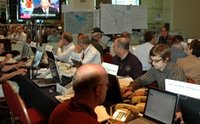Exercising the Team
 This week we’ll conduct a major counterterrorism exercise, so I want to take an opportunity to fill you in on just what it will entail, the benefits it will produce, and why we conduct exercises in the first place.
This week we’ll conduct a major counterterrorism exercise, so I want to take an opportunity to fill you in on just what it will entail, the benefits it will produce, and why we conduct exercises in the first place.The Top Officials 4 exercise (or TOPOFF 4 as it’s commonly called) is a week-long endeavor that starts today and focuses on simulated terrorist incidents occurring in Arizona, Oregon, and the U.S. territory of Guam. It’s the fourth of a series of congressionally-mandated exercises that involves participants at all levels of government, the private sector, as well as some of our international partners. In fact, TOPOFF 4 will be the largest and most comprehensive national-level exercise to date, and will include more than 15,000 participants.
It will not only test our ability to respond effectively to multiple attacks, but also provide a realistic environment in which to assess our preparedness efforts and enhance coordination among federal, state, local and international partners.
A full-scale exercise like TOPOFF 4 is incredibly valuable. Responding to and effectively managing a terrorist attack or natural disaster requires close coordination with a variety of people and organizations. Problems with logistics, personnel, and information flow can cost lives and must be worked out before a disaster strikes, rather than in the middle of a crisis. Exercises are a welcome opportunity to address these issues.
Similar to the way football teams practice for game day, we prepare for real world disasters by constantly conducting small exercises throughout the year, and applying what we learn to larger and more complex events like TOPOFF. Our goal is to push our systems to the breaking point--and beyond--to help us better understand what things perform well and what areas need work.
After we complete an exercise, we review the results, address any problems that arose, and share the lessons learned with our homeland security partners throughout the government and private sector. While not released to the general public, we do circulate these results promptly to our state and local partners to reduce vulnerabilities identified within the exercise. Most importantly, we apply these lessons learned to real-world situations.
Thanks for reading, and I look forward to hearing from you.
Michael Chertoff
Labels: counterterrorism, preparedness


0 Comments:
Post a Comment
Create a Link
<< Home